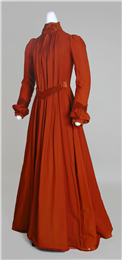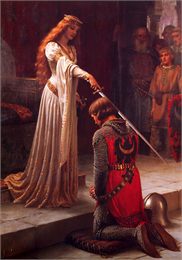1880s "Aesthetic" Dress
Wisconsin Historical Museum Object – Feature Story

Red dress inspired by "Aesthetic" Movement, 1881
Source: Wisconsin Historical Museum object #1952.128

Inside of the dress, 1881
Inside of the dress showing the tight fitting under-bodice. Source: Wisconsin Historical Museum object #1952.128

"The Accolade" by Edmund Blair Leighton, 1901
In this Pre-Raphaelite painting the queen wears a kirtle, the inspiration for the late-nineteenth century aesthetic gown. Source: "The Accolade" by Edmund Blair Leighton, 1901. Image courtesy of the Art Renewal Center, www.artrenewal.org

Advertisement for Liberty & Co. aesthetic dress
An advertisement for Liberty & Co. showing a kirtle-inspired aesthetic dress very similar to Annie Cronk’s tea gown. Source: English Women’s Clothing in the Nineteenth Century, courtesy of Leslie Bellais
Tea gown inspired by the "Aesthetic" Movement of the late nineteenth century, worn by Annie Cronk of Oregon, Wisconsin, c. 1881.
(Museum object #1952.128)
Annie Cronk, the daughter of a farmer and the wife of a railroad station agent, raised a family in rural Oregon, Wisconsin, in the late 1800s. While in her mid thirties, Mrs. Cronk owned this tea gown done in the latest "aesthetic" style. She may have harbored romantic artistic aspirations, but as a station agent's wife in rural Wisconsin she was hardly living in a Pre-Raphaelite painting with its romanticized images of medieval women in long-flowing gowns. Although some saw the aesthetic dress as a pretentious garment designed only for artistic women that languished poetically on sofas, the innovative construction helped to revolutionize women's clothing.
The aesthetic style in dress came into being during the Arts and Crafts and Pre-Raphaelite movements of the late nineteenth century. After the rise of the Industrial Revolution and mass manufacturing, artists desired a return to the quality and beauty of handmade products, and the English medieval era provided the idyllic model. Art and literature propagated this trend, creating the Pre-Raphaelite movement, which produced works that hearkened back to knights and ladies of the medieval period. Fashion followed suit, shaping gowns to look like the typical kirtle, a long, loose-fitting outer garment worn by women in the Middle Ages.
The silhouette and structure of the gown were undeniably different from the typical dress of the late nineteenth century. Usually constructed without constrictive boning that contorted women's bodies into the fashionable hour-glass shape of that period, aesthetic gowns were meant to be worn without a corset. The loosely-fitted bodice and waist made the gown a liberating and functional garment in the freedom of movement it allowed, if only indoors since to be outside without a corset would still have been considered indecent. These dresses did have, however, a tight fitting under-bodice that provided a sense of support that women were not quite willing to give up.
Annie Cronk's aesthetic dress is made of reddish-brown wool with matching velvet trim, a color consistent with the rich autumnal palette of the aesthetic movement. Her gown's high, snug collar, long sleeves with a puff at the wrist, short train, and a loose bodice, lightly bound by a pointed velvet belt make it a good example of the typical aesthetic style. Aesthetic dresses also generally had a minimal amount of ornament, allowing beautiful fabrics to be the decoration, producing a look that differed radically from the elaborate trimmings of dresses from the 1870s and 1880s.
Annie (Richards) Cronk was born in Connecticut in 1844 to Homer and Sarah Richards. When Annie was twelve years old, the family moved to Footville, Wisconsin. Annie and her mother were teachers, and her father worked as a farmer, selling grain and produce. In the mid-1860s, Annie married Charles H. Cronk, a railroad station agent in Footville. The Cronk family moved to Oregon, Wisconsin, where Charles continued his career as station agent. The couple had four children.
As a teacher, perhaps Mrs. Cronk had aspirations of the bourgeoning artistic and intellectual developments of the late Victorian era and, as a woman that had worked on a farm in her youth, she may also have been aware of the practical benefits of a looser fitting garment. But this garment represents more than a healthful method of dress, it represents liberation for women from certain constraints in society. While wearing this dress, Mrs. Cronk was doing more than taking a positive step towards improving her health, she was also making a statement. This gown revealed her knowledge of a revolution in women's dress, and, by wearing it, included herself in the artistic circle, a group that was by no means the majority.
Annie Cronk, like most women who enjoyed the aesthetic dress style, may well have done so strictly within societal boundaries, wearing the gown only in the privacy of her own home, but the movement initiated a wider reconsideration of women's fashion. Highly influenced by the perceived romance of Medieval Europe, the Aesthetic Movement reached many circles of American society, including the rural farmlands of Wisconsin, and changed women's clothing forever.
Learn More
Have Questions?
For more information or to purchase an image of one of the objects featured in Curators' Favorites, contact our staff by email below:
[Sources: Cunningham, Patricia A. "Reforming Women's Fashion, 1850-1920" (Kent, OH: Kent University Press, 2003); Fuller, Judith. "Patterns of History, 1881: Period Notes" (Madison, WI: The State Historical Society of Wisconsin, 1979); Cunnington, C. Willett. "English Women's Clothing in the Nineteenth Century" (New York: Dover Publications, 1990); "Introduction to the Pre-Raphaelite Movement"; Image of Edmund Blair Leighton's "The Accolade," Source: Art Renewal Center.]
MLM
Posted on July 10, 2008
